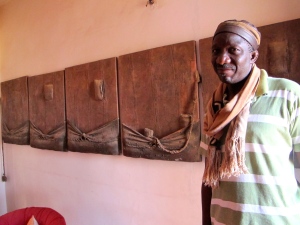By Robin Riskin
A brown bonnet cap and gentle smile bedeck Viyé Diba, one of the forefathers of contemporary art in Senegal. Rich canvases and multi-media installations cover the walls of his airy whitewashed home. The upper floor is a sunlit cove of Diba originals.
Diba’s mystical abstract artworks are rooted in sensibilities of movement, rhythm, and spirituality that speak to a global nation. The canvases mix hues of reds, browns, and grays with bits of rope, plastic, toile, and other materials. Wooden beams guide the movement, while disfigurations texture the backdrop.
Diba uses local and recycled materials found in the environments he depicts. Rather than signing with his name, he marks each work with a patch of faded color. The sense of geometry, gravity, and horizontality in his art stems from his interest in dance, which he describes as the most potent form of human expression. More recently, Diba has experimented with plastics, consumerist products, and spacious installations, such as his works for the past several Dak’Art Biennales, and for the 2011 Tang Museum exhibition, “Environment and the Object” at Skidmore College.
Although strong in math and science, Diba decided to attend Ecole des Beaux Arts (now Ecole Nationale des Arts) in order to make a living as an art teacher. When he won a scholarship to study in France, he discovered art as not just a profession but a passion. He wrote a dissertation for his Ph.D in urban studies that compared the city of Nice, France to that of Dakar. Diba has spearheaded a movement of abstract art in Senegal; exhibited in the likes of Johannesburg, Paris, and Washington; and served as the President of the National Senegalese Association of Visual Artists. He is interested in questions of people and space, urban environments, and social aesthetics. He uses art as a strategy to analyze history, represent society, and imagine solutions for the future.
“Matières et Sentiments” (Materials and Feelings), 1996
Each piece of the seven-panel installation links to its neighbor through a rope and alternating mallet or pocket. Subtle vertical lines pull the motion downward to meet strips of canvas tied into thick bows. Ruddy brown tones emphasize a bond with the Earth, while the weight at the bottom delineates the pull of gravity. The works capture a relationship between space, form and human sentiment. The yearning for connection reflects Diba’s interest in communication that extends beyond the vocal.
“Robinet” (Faucet), 2010
Frustrated by a Chinese-imported faucet that he had to replace seven times, Diba traced out and replicated the faucet’s contour until it covered an entire canvas. The gray shapes fill the frame under a gauze of toile, and become visible through a window-like sliver of cellophane. On top of the window is written “421,” the total number of faucets in the frame. With a pristine geometric abstraction, the piece demonstrates the repetition of wastefulness in the 21st century routine.





